Creating a Stylish Key Table for Your Entryway
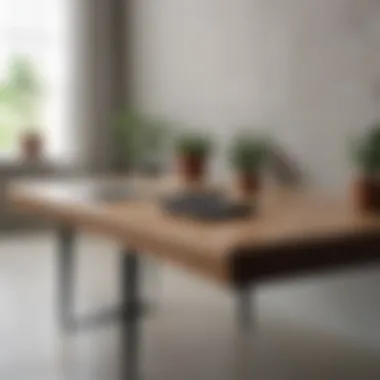
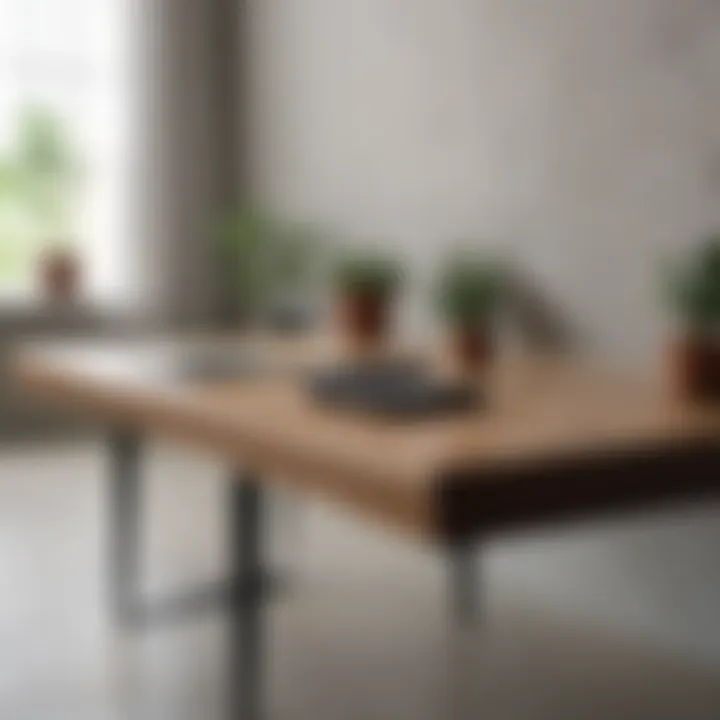
Intro
Creating a functional table for keys that is placed by the door is more than just a simple task. It involves a thoughtful approach that considers prakticality and style. Homeowners and renters alike can benefit from an organized entryway. Key tables serve a dual purpose: they keep keys accessible and contribute to the overall decor of the space.
In this article, we will explore various design inspirations, diving into trending styles and color palettes. Additionally, we will discuss material options and functionalities that enhance the user experience. Seasonal maintenance tips will aid in the upkeep, ensuring that the keys table retains its charm and utility over time. By the end of this guide, you will have a clear vision of how to create a welcoming entryway that reflects your personal style.
Design Inspirations
Designing a table for keys can reflect your individual taste while catering to your functional needs. Style choices can greatly influence the overall feel of your entryway. A well-designed table can serve as a focal point that invites people into your home.
Trending Styles
When considering trending styles for your keys table, it is important to take stock of current trends in interior design. Minimalism is quite popular, which emphasizes a clean and uncluttered space. You might opt for a sleek, low-profile table with hidden storage. Traditional designs, with wood finishes and ornate details, continue to charm many. On the other hand, industrial styles can add a unique touch with their use of metal and reclaimed wood.
Other styles to consider include:
- Farmhouse: Emphasizes rustic charm, often featuring distressed wood.
- Scandinavian: Combines functionality with simplicity and light colors.
- Modern: Focuses on geometric shapes and a mix of materials.
Color Palettes
Colors can dramatically affect the atmosphere of your entryway. When selecting a palette for your keys table, think about the broader color scheme of the room. Warm tones like beige and terracotta can create an inviting feel. Cool colors like blu and gray may prompt a sense of calm.
Consider incorporating contrasts for visual interest. Here are some effective color combinations:
- White and Light Wood: Clean and fresh look.
- Navy Blue and Gold Accents: Adds sophistication and depth.
- Teal and Natural Wood: A vibrant yet earthy choice.
"A well-considered color palette can transform an ordinary entryway into a space that captures one’s essence."
When crafting a keys table, it is also valuable to think about functionality alongside aesthetics. The materials used for your table can impact both its durability and its visual appeal.
Importance of a Key Table
A table for keys, strategically placed by the door, serves as more than a mere piece of furniture. It holds a significant role in enhancing the functionality of an entryway. In this guide, we will explore why a dedicated space for keys is crucial, emphasizing its organizational benefits and aesthetic contributions.
Organizational Benefits
The primary purpose of a key table is organization. When keys are easily accessible, it reduces the stress associated with misplacing them. Every homeowner knows the frustration of searching for keys in a hurry. A table designated for keys provides a specific spot to set them down upon entering the home.
Incorporating compartments, hooks, or trays can provide added structure. For instance, one can dedicate a space for house keys, car keys, and even spare keys. This not only keeps them in one place but also ensures that each key is readily available.
Additionally, a key table can serve as a mini command station. Placing important mail or notes nearby can change the way you manage daily tasks. Items like reminders or bills can be temporarily stored here, making them easier to remember later.
Aesthetic Contributions
Beyond functionality, a key table can significantly contribute to the aesthetics of an entryway. The choice of materials, colors, and style can reflect personal taste and harmonize with existing decor. A well-designed key table can enhance the first impression of a home, inviting guests into a thoughtfully curated space.
For example, if the home has a modern theme, a sleek metal or composite table might fit perfectly, creating a clean look. On the other hand, a rustic wooden table can add warmth to a more traditional environment.
In summary, a key table addresses both practical needs and visual appeal. By acknowledging these two aspects, homeowners can create a functional and attractive entryway.
"A key table combines utility and charm, serving a crucial role in everyday life while contributing to the overall design of the home."
Establishing such a piece requires consideration of both organization and aesthetics, and this guide will further delve into design considerations to help achieve the ideal setup.
Key Design Considerations
Key design considerations create the backbone of a functional table for keys. Understanding how size, material, and finish affect the design can elevate both practicality and style. Every element must work harmoniously, ensuring that the table suits the unique demands of an entryway while complementing surrounding decor.
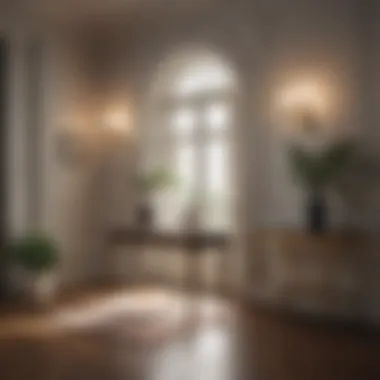

Size and Proportions
The size and proportions of the table are crucial considerations. They directly affect functionality and the visual balance of the entryway. A table that is too large can overwhelm a small space, while one that is too small may not offer adequate storage or surface area for everyday items. Therefore, it’s essential to measure the area where the table will be placed before deciding on dimensions. Typically, a height of 30 inches is standard for tables, making it easy to access items. The depth and width should follow the space available without blocking pathways. Consideration of these factors ensures the table becomes an integrated aspect of the entryway rather than an obstruction.
Material Choices
Wood
Wood is a popular choice for its warmth and natural appeal. It contributes to a welcoming atmosphere, which is ideal for an entryway. The key characteristic of wood is its versatility. It can be stained or painted to match existing decor, making it a beneficial choice for various styles. Oak, pine, and maple are often favored due to their durability. Additionally, wood’s unique grain patterns can add visual interest to the table. However, one must consider that wood may require regular maintenance to avoid scratches and water damage.
Metal
Metal offers a sleek, modern aesthetic that appeals to many homeowners today. Its key characteristic is strength; metal tables can withstand heavy daily use without warping or bending. Common metals include stainless steel and aluminum, both of which also resist corrosion. Their unique feature is the industrial look they provide, suitable for contemporary designs. However, metal may feel colder than wood, which some might find uninviting. The surface can scratch easily, depending on the finish used.
Composite
Composite materials merge durability with design flexibility. They can mimic the appearance of wood or metal while being lighter and more affordable. The key feature of composites is their resistance to moisture and warping, making them excellent for entryways prone to humidity. Composite tables can be manufactured in a variety of colors and textures, allowing for many design possibilities. However, some higher-quality composites may still fall short compared to solid wood or genuine metal in terms of longevity and craftsmanship.
Finish and Texture
Finish and texture are not just aesthetic considerations; they directly impact how the table will be used and maintained. A textured surface may provide grip, preventing items from sliding off, while a smooth finish can make cleaning easier. Common finishes include matte, glossy, or distressed, each offering a distinct look and feel. The choice of finish should align with lifestyle. For example, homes with pets or children may benefit from a more durable finish that can withstand wear and tear. Additionally, understanding texture is important in tying together the overall design scheme, ensuring the table speaks to the design language of the space.
Functional Features
In designing a table for keys by the door, functional features play a crucial role. These are the elements that enhance usability and organization, making the table not only a decorative piece but a highly practical one. When considering how to use this table effectively, various features should be included. Not only do they serve a purpose, but they also contribute to an overall efficient entryway experience. Understanding the different options available allows homeowners and renters to make informed decisions that align with their personal needs and lifestyle.
Storage Solutions
Drawers
Drawers are a key aspect of any functional key table. They provide hidden storage, allowing for the neat organization of smaller items such as spare keys, sunglasses, or mail. Their practical nature makes them a popular choice. One notable characteristic of drawers is that they can be customized in depth and size to fit the specific needs of the user.
A unique feature of drawers is their ability to keep items out of sight, promoting a clean and uncluttered look in the entryway. However, a potential disadvantage is that if not organized regularly, they can become a catch-all for miscellaneous items, thus losing their original purpose of organization.
Shelves
Shelves offer another viable storage solution. They can accommodate larger items and provide easy access to frequently used objects. A highlight of shelves is their open design, which can enhance the visual appeal of the space while serving a practical function. They can be used to display decorative items alongside essential belongings like keys or bags.
The main advantage of shelves is that they promote organization without the need to open drawers, which can be time-consuming. However, one must consider that open shelves require ongoing maintenance to ensure that the items displayed remain tidy and visually appealing, adding a layer of upkeep.
Hooks
Hooks serve as an excellent addition to any key table. They are ideal for hanging items such as keys, bags, or accessories. The convenience of hooks lies in their easy access; users can quickly grab what they need upon entering or exiting the house. A key characteristic of hooks is their versatility; they can be mounted at various heights to accommodate different users.
A unique feature of hooks is their ability to add dimension to the table, often enhancing the overall design of the entryway. The disadvantage with hooks, however, is that they might lead to clutter if excessive items are hung, reducing the initial appeal of being organized.
Integrated Technology
Incorporating technology into the table design can significantly enhance its functionality. This integration ensures that the key table meets modern lifestyle demands, offering convenience while maintaining organizational aesthetics.
Charging Stations
A charging station is a beneficial feature for a key table. It provides a practical solution for keeping devices powered up. With the increasing reliance on smartphones and other electronic devices, having a dedicated charging point near the door is invaluable. A standout characteristic of charging stations is their ability to keep cords organized and out of sight, preserving the table's tidy appearance.
The main advantage of integrating a charging station is that it encourages users to have a designated area for their devices, preventing them from being misplaced. A drawback might be the requirement for access to an electrical outlet, which can limit where the table can be placed.
Smart Home Integration
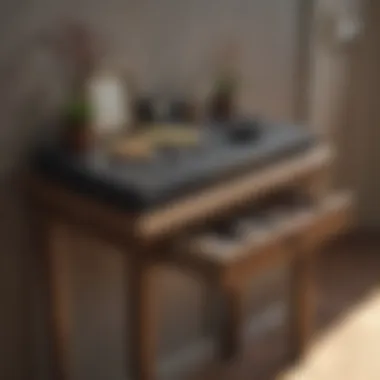
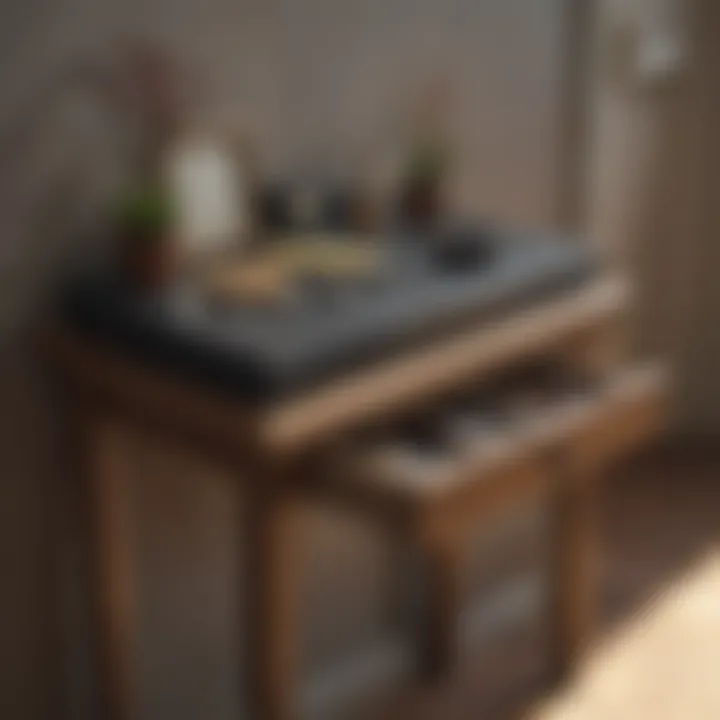
Smart home integration is another appealing feature for modern homes. Tables that support this technology can sync with home automation systems, allowing users to control items like lights or security systems from the entryway. A key highlight of this feature is its ability to enhance security and convenience.
One unique advantage of smart home integration is that it centralizes control, making life more efficient. However, it requires familiarity with technology, which might be off-putting for some users. Additionally, costs for smart systems can vary significantly, which can be a factor in deciding on this feature.
A table that combines storage solutions with integrated technology bridges functionality and modern design in an entryway.
Establishing a Cohesive Design
Creating a functional table for keys by the door goes beyond mere utility. Establishing a cohesive design brings together multiple aesthetic and functional elements that can make or break the overall appeal of the entryway. It’s about balancing style with purpose, ensuring that the table does not stand out for the wrong reasons but instead integrates smoothly into the existing design of your home.
Matching Entryway Aesthetics
The entryway serves as the first impression of your home. When designing a key table, matching its aesthetics to the overall style of the entryway is crucial. Consider elements such as color, material, and shape. A modern home may benefit from sleek lines and minimalistic styles, while a traditional space might require ornate details and classic wood finishes.
- Color Coordination: Select colors that align with your entryway's palette. Neutrals tend to offer flexibility, while bolder tones can act as a statement piece.
- Material Harmony: If your entryway features metal accents, incorporating similar materials in your key table can enhance unity. Likewise, wooden tables should complement other wooden elements in the space.
- Shape Integration: The shape of the table should correspond to the overall layout of the entryway. For instance, a round table can soften sharp corners and create a welcoming vibe.
Creating Visual Harmony
Visual harmony involves ensuring that all components in your entryway work together seamlessly. This requires an understanding of proportions and spacing as well as attention to detail.
- Balance: Strive for a balance between the table and surrounding elements. A large table in a tight space can feel oppressive, while a smaller one may get lost.
- Symmetry and Asymmetry: Decide if you want a symmetrical setup with matching decor on either side or an asymmetrical arrangement that adds character and interest. Both approaches can contribute to harmony if executed thoughtfully.
- Consistent Themes: Choose decorative items that resonate with a theme. For example, a rustic theme can be enhanced with vintage trays or wrought iron hooks.
By focusing on these details, you ensure that not only does the key table serve its practical purpose but it also elevates the style of your home. This interplay between functionality and aesthetics is essential for any homeowner or interior design enthusiast aiming to create a welcoming ambiance.
DIY Table Ideas
In the pursuit of a quality table for keys, many individuals overlook the potential of creating something personalized. DIY table ideas carry significant importance as they allow homeowners to express their style while decisively meeting functional needs. A self-made table ensures that every aspect, from size to finish, aligns with the unique requirements of the entryway. Moreover, engaging in a DIY project can foster a sense of accomplishment and commitment to enhancing home organization.
Simple Constructive Approaches
Creating a functional key table does not have to be overly complex. Simple constructive approaches can yield excellent results. Start with basic materials like plywood or reclaimed wood. These materials are usually affordable and can be found easily. Measure the space available at your door, keeping in mind the height and width. Cutting the wood to just the right size allows for a customized fit.
Consider a basic design that features a flat surface supported by sturdy legs. Use wood glue and screws to secure connections. This straightforward design provides a solid foundation for keys and other items.
Paint or stain the surface for an appealing finish. Both options provide protection against wear and add to the aesthetic. Using a bright color can offer a visual cue in the chaos of an entryway.
Repurposing Existing Furniture
For those who desire a more sustainable approach, repurposing existing furniture is an excellent option. Rather than purchasing new materials, look around your home. An old bookshelf or a side table may serve as a perfect base.
Removing unwanted items from furniture can reveal hidden potential. For instance, an old nightstand can transform effectively into a key table. Simply add hooks beneath the top surface for keys and small items while keeping the drawer for additional storage.
A few coats of paint can also breathe new life into old pieces, allowing you to match them to the existing design of your home. This not only saves money but is also an environmentally friendly choice.
Repurposing adds character to any space. It tells a story and reflects personal choices.
Engaging in DIY projects fosters creativity. Each table created is unique, tailored to the owner's desire, and often has a hidden history.
Ultimately, the DIY approach provides an excellent opportunity for creativity and personalization. Whether constructing a new table from scratch or repurposing furniture, individuals can ensure that their key table meets aesthetic and functional needs.
Accessorizing the Key Table
Accessorizing the key table is integral to combining style, functionality, and personalization. Through proper accessorizing, a key table transitions from a mere functional piece into a cohesive part of the decor. The right accessories serve practical purposes, such as facilitating organization and improving accessibility, while also adding visual appeal to the entryway. Key considerations include choosing elements that can withstand wear and align with the overall aesthetic of the surrounding space.
Decorative Elements
Plant Holders
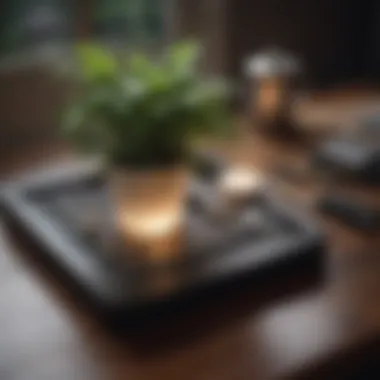
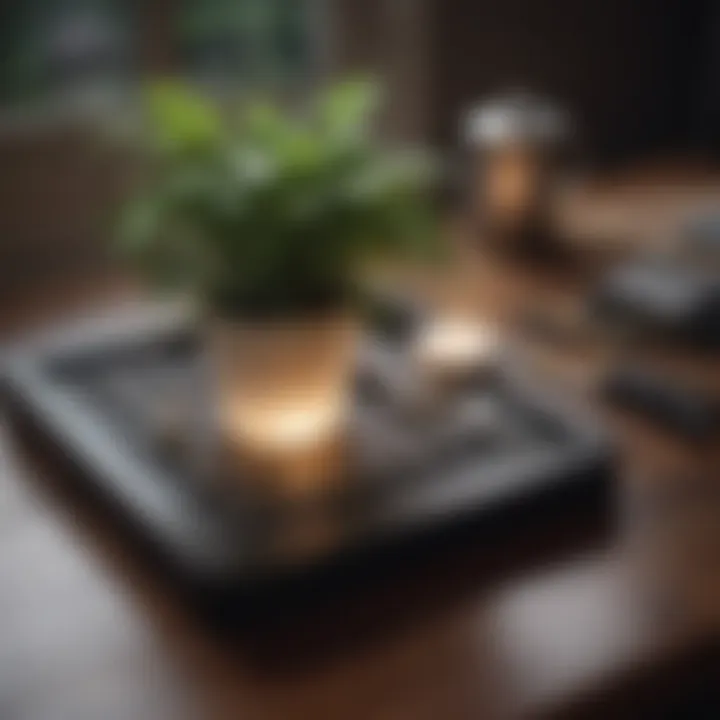
Plant holders can nourish the atmosphere around the key table. They enhance the decor while introducing a touch of nature. Succulents or small indoor plants can thrive in these holders, requiring minimal care and offering maximum vitality. Their vibrant greens provide a dynamic contrast against wood or metal finishes, attracting the eye. However, it is crucial to consider placement to avoid cluttering the table top. Over time, soil and watering can create mess, requiring care in selection and maintenance.
Artwork
Artwork can significantly elevate the entrance's personality. A simple frame or wall-mounted piece offers a dynamic focal point above the key table. It reflects personal taste, serving as a conversation starter. Choosing artwork that complements the table's material or color scheme reinforces a unified aesthetic. However, the size and scale are critical; oversized pieces can overwhelm small spaces, while miniature artworks risk going unnoticed. Thus, careful selection can really enhance the entryway.
Trays
Trays are practical items that foster organization. They collect smaller items like keys, coins, or miscellaneous tools, preventing clutter on the table surface. Stylish trays come in various designs, material and finishes, allowing for easy customization. Using a tray can simplify keeping track of items so they won't get lost. Yet, trays require regular cleaning, and if too many items accumulate, the effect can turn from orderly to chaotic. Careful consideration in what goes into the tray is required.
Functional Add-Ons
Multi-Function Devices
Multi-function devices amplify the capabilities of a key table. Examples include charging stations or integrated security systems. They provide essential functions that adapt to modern needs while preserving space. Such devices often blend seamlessly with decor, enhancing utility without sacrificing style. However, installation might require an electrical outlet nearby, limiting placement options. Thus, it's essential to weigh the advantages against the constraints they may impose on positioning.
Labels
Labels serve as practical solutions for organization, especially in households with various members. They can clarify where items belong, enhancing the efficiency of the table's use. Custom labels can add a personal touch, crafted to fit the design theme. The downside might be that constant changes can make keeping labels updated a chore. Nonetheless, effective labeling can streamline daily routines, creating a more functional entryway.
Maintaining the Table's Functionality
Maintaining the functionality of a key table is paramount for ensuring that it serves its purpose effectively. A well-organized and clean table can drastically enhance the accessibility of keys and other essentials. This section highlights the routine organization and cleaning & care practices that can help keep the table functional and user-friendly.
Routine Organization
Routine organization is essential for ensuring a smooth flow in daily life. To maintain an efficient key table, establish a regular schedule for organizing the items. This not only prevents clutter but also allows for a seamless experience when you need to grab your keys.
Begin by decluttering the surface on a regular basis. Remove unnecessary items that often accumulate, like old mail or receipts. Consider implementing designated areas for different items, such as:
- Key Hooks: Assign specific hooks for each family member's keys. This keeps them identifiable and easily accessible.
- Themed Trays: Utilize trays for specific items like sunglasses or masks. This helps to separate different categories, minimizing confusion.
- Designated Basket: Have a small basket for miscellaneous items that often get dropped near the table.
Monthly checks can be beneficial to reevaluate the system. Adjustment may be needed based on the household’s evolving needs. Keep a simple checklist to remind yourself of what should stay and what might need to go.
Cleaning and Care
Cleaning is an often overlooked aspect of maintaining a functional table but is equally as necessary. Regular cleaning preserves not only the appearance of your key table but also its functionality over time.
Start with basic dusting, using a soft cloth, to keep surfaces clear of dirt and dust. It’s advisable to wipe down the table weekly, especially during seasons of high activity, like the holiday season or moving months.
For deeper cleaning, the following steps can be taken:
- Surface Cleaning: Use a gentle cleaning solution suitable for the material of your table to avoid damage.
- Inspect Hardware: Check any hooks or drawers for loose screws or wear. Tighten or replace them as needed.
- Seasonal Maintenance: Every few months, take time to assess both appearance and utility. Restore the finish of wooden tables as required to keep them looking fresh.
By integrating consistent organization and thorough cleaning into your maintenance routine, the functionality of a key table improves significantly. This approach not only enhances the aesthetics but also contributes to creating a pleasant and efficient entryway.
"An organized space increases productivity and reduces stress levels in daily tasks."
Maintaining a key table's functionality is about fostering a conducive environment by ensuring that it remains organized and clean. This practice ultimately encourages a more inviting and efficient entryway.
Ending
Incorporating a key table into your home enhances organization. No more frantic searches for misplaced keys; everything has its designated place. This saves time and reduces stress, particularly during busy mornings when efficiency is vital. A thoughtfully designed table can also contribute to the overall aesthetic of the home, creating a welcoming and harmonious entryway. It can act as a focal point, showcasing the owner's tastes and preferences while blending seamlessly with existing decor.
Considerations about functionality and aesthetics should remain at the forefront throughout the design process. Selecting appropriate materials, sizes, and features will ensure that the table is not only of use but also stands the test of time in style. The tips for DIY options encourage creativity, allowing individuals to personalize their pieces according to their needs and desires.
Ultimately, it is this balance of aesthetics and functionality that makes a key table an essential element of any entryway. As you embark on your journey to design or improve your key table, keep in mind the lessons learned here. These fundamental aspects can lead to a more organized, stylish, and inviting home.
Final Thoughts
From integrated technology that streamlines daily tasks to designs that enhance the visual appeal, the choices are vast. Emphasizing the importance of routine organization and easy access can further enrich the user experience.
With this comprehensive guide, homeowners and design enthusiasts can appreciate the multifaceted benefits of a key table. By employing sound design principles and practicality, creating a well-suited key table not only improves organization but also brings a cohesive style to the entryway. Being mindful of these aspects will ensure a welcoming space that reflects personal taste.







